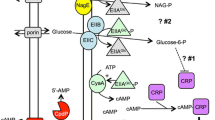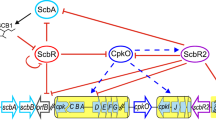Abstract
CO2 regulates gene expression across a diverse group of microorganisms including fungi, and both photosynthetic and non photosynthetic bacteria. The processes that CO2 regulates are diverse. Several CO2-responsive random promoter lacZ fusions of unknown function have been isolated from a marine Synechococcus and a Pseudoalteromonas sp., highlighting the wide effect of CO2 control in these organisms. Regulatory proteins have been described that mediate the CO2 response at transcription level in Bacillus anthracis, the group A streptococci and two Rhodobacter spp.. These regulatory proteins include: AcpA and AtxA that are involved in CO2 control of B. anthracis capsule and toxin production; Mga that regulates surface associated virulence factors in the group A streptococci; and RegB/A, a two component signal transduction system that responds to environmental stimuli including CO2, to regulate photosynthetic apparatus and CO2 fixation enzyme synthesis in Rhodobacter spp..
Similar content being viewed by others
References
Albertson NH, Stretton S, Pongpattanakitshote S, Goodman AE & Kjelleberg S (1996) Construction and use of a new mini-Tn10:lac:kantransposon to identify environmentally responsive genes. FEMS Microbiol. Letts. 140: 287-294
Ashie INA, Smith JP & Simpson BK (1996) Spoilage and shelf-life extension of fresh fish and shellfish. Crit. Rev. Food Sci. Nut. 36: 87-121
Barktus JM & Leppla SH (1989) Transcriptional regulation of the protective antigen gene of Bacillus anthracis.Infect. Immun. 57: 2295-2300
Bartnicki-Garcia S & Nickerson WJ (1962) Induction of yeastlike development in Mucorby carbon dioxide. J. Bacteriol. 84: 829- 840
Bécard G & Piché Y (1989) Fungal growth stimulation by CO2 and root exudates in vesicular-arbuscular mycorrhizal symbiosis. Appl. Environ. Microbiol. 55: 2320-2325
Becker S, Holighaus G, Gabrielczyk T & Unden G (1996) O2 as the regulatory signal for FNR-dependent gene regulation in Esherichia coli. J. Bacteriol. 178: 4515-4521
Caparon MG, Geist RT, Perez-Casal JR & Scott J (1992) Environmental regulation of virulence in group A streptococci: transcription of the gene encoding m protein is stimulated by carbon dioxide. J. Bacteriol. 174: 5693-5701
Cataldi A, Fouet J & Mock M (1992) Regulation of paggene expression in Bacillus anthracis: use of a pag-lacZtranscriptional activator. FEMS Microbiol. Letts. 98: 89-94
Conley PB, Lemaux PG & Grossman AR (1985) Cyanobacterial light-harvesting complex subunits encoded in two red light-induced transcripts. Science. 230: 550-553
Costerton JW, Cheng KJ, Geesey GG, Ladd TI, Nickel JC, Dasgupta M & Marrie TJ (1987) Bacterial biofilms in nature and disease. Ann. Rev. Microbiol. 41: 435-464
Costerton JW, Lewandowski Z, Caldwell DE, Korber DR & LappinScott HM (1995) Microbial biofilms. Annu. Rev. Microbiol. 49: 711-745
Cotty PJ (1987) Modulation of sporulation of Alternaria tageticaby carbon dioxide. Mycologia. 79: 508-513
Dahlberg KR (1982) Physiology and biochemistry of fungal sporulation. Ann. Rev. Biochem. 20: 281-301
Dai Z, Sirard JC, Mock M & Koehler TM (1995) The atxA gene product activates transcription of the anthrax toxin genes and is essential for virulence. Mol. Microbiol. 16: 1171-1181
Daniels JA, Krishnamurthi R& Rizvi SSH (1985) A review of effects of carbon dioxide on microbial growth and food quality. J. Food. Prot. 48: 532-537
de Beer D, Stoodley P, Roe F & Lewandowski Z (1994) Effects of biofilm structures on oxygen distribution and mass transport. Biotech. Bioeng. 43: 1131-1138
Denyer SP, Davies MC, Evans JA, Finch RG, Smith DG, Wilcox MH & Williams P (1990) Influence of carbon dioxide on the surface characteristics and adherence potential of coagulase-negative staphylococci. J. Clin. Microbiol. 28: 1813-1817
Desgranges C & Durand A(1990) Effect of pCO2 on growth, conidation, and enzyme production in solidstate culture on Aspergillus nigerand Trichoderma virideTS. Enzyme Microb. Technol. 12: 546-551
DiRita VJ & Mekalanos JJ (1989) Genetic regulation of bacterial virulence. Ann. Rev. Genet. 23: 455-482
Dixon NM & Kell DB (1989) The inhibition by CO2 of the growth and metabolism of micro-organisms. J. Appl. Bacteriol. 67: 109- 136
Eraso JM & Kaplan S (1994) prrA, a putative response regulator involved in oxygen regulation of photosynthesis gene expression in Rhodobacter sphaeroides. J. Bacteriol. 176: 32-43
Eraso JM & Kaplan S (1995) Oxygen-insensitive synthesis of the photosynthetic membranes of Rhodobacter sphaeroides: a mutant histidine kinase. J. Bacteriol. 177: 2695-2706
Eyles MJ, Moir CJ & Davey JA (1993) The effects of modified atmospheres on the growth of psychrotrophic pseudomonads on a surface in a model system. Int. J. Food Microbiol. 20: 97-107
Haigh R, Baldwin T, Knutton S & Williams WH (1995) Carbon dioxide regulated secretion of the EaeB protein of enteropathogenic Escherichia coli. FEMS Microbiol. Letts. 129: 63-68
Hengge-Aronis R (1995) Regulation of gene expression during entry into stationary phase. In: Neidhardt FC (Ed) Escherichia coliand Salmonella- Cellular and Molecular Biology, (pp 1497-1512). ASM Press, Washington, D.C.
Hill S (1988) How is nitrogenase regulated by oxygen? FEMS Microbiol. Rev. 54: 111-130
Iuchi S, Matsuda Z, Fujiwara T & Lin ECC (1990) The arcBgene of Escherichia coliencodes a sensor-regulator protein for anaerobic repression of the arcmodulon. Mol. Microbiol. 4: 715-727
Kass EH, Kendrick MI, Tsai YC & Parsonnet J (1987) Interaction of magnesium ion, oxygen tension, and temperature in the production of toxic-shock-syndrome toxin-1 by Staphylococcus aureus.J. Infectious Dis. 155: 812-815
Kepkay PE, Schwinghamer P, Willar T & Bowen AJ (1986) Metabolism and metal binding by surface colonising bacteria: results of microgradient measurements. Appl. Environ. Microbiol. 51: 163-170
Knowles JR (1989) The mechanism of biotindependent enzymes. Annu. Rev. Biochem. 58: 195-221
Koehler TM, Dai Z & Kaufman-Yarbray M (1994) Regulation of the Bacillus anthracisprotective antigen gene: CO2 and a trans-acting element activate transcription from one of two promoters. J. Bacteriol. 176: 586-595
Kozliak EI, Fuchs JA, Guilloton MB & Anderson PM (1995) Role of bicarbonate/CO2 in the inhibition of Escherichia coligrowth by cyanate. J. Bacteriol. 177: 3213-3219
Krebs HA (1941) Carbon dioxide assimilation in heterotrophic organisms. Nature. 147: 560-563
Lannelongue M & Finne G (1986) Effect of carbon dioxide on growth rates of selected microorganisms isolated from black drum pogonias-cromis. J. Food Protec. 49: 806-810
Leganés F & Valiente EF (1991) The relationship between the availability of external CO2 and nitrogenase activity in the cyanobacterium NostocUAM 205. J. Appl. Physiol. 139: 135-139
Makino S, Sasakawa C, Uchida I, Terakado N & Yoshikawa M (1988) Cloning and CO2-dependent expression of the genetic region for encapsulation from Bacillus anthracis. Mol. Microbiol. 2: 371-376
McIntyre M & McNeil B (1997) Dissolved carbon dioxide effects on morphology, growth, and citrate production in Aspergillus nigerA60. Enzyme Microb. Technol. 20: 135-142
McIver KS, Heath AS & Scott JR (1995a) Regulation of virulence by environmental signals in group A streptococci: influence of osmolarity, temperature, gas exchange, and iron limitation on emmtranscription. Infect. Immun. 63: 4540-4542
McIver KS, Heath AS, Green BD & Scott JR (1995b) Specific binding of the activator Mga to promoter sequences of the emmand scpAgenes in the group A streptococcus. J. Bacteriol. 177: 6619-6624
Mekalanos JJ (1992) Environmental signals controlling expression of virulence determinants in bacteria. J. Bacteriol. 174: 1-7
Miller JF, Mekalanos JJ & Falkow S (1989) Coordinate regulation and sensory transduction in the control of bacterial virulence. Science. 243: 916-922
Mosley CS, Suzuki JY & Bauer CE (1994) Identification and molecular genetic characterization of a sensor kinase responsible for coordinately regulating light harvesting and reaction center gene expression in response to anaerobiosis. J. Bacteriol. 176: 7566-7573
Nguyenthe C & Carlin F (1994) The microbiology of minimally processed fresh fruits and vegetables. Crit. Rev. Food Sci. Nut. 34: 371-401
Okada N, Geist RT & Caparon MG (1993) Positive transcriptional control of mryregulates virulence in the group A streptococcus. Mol. Microbiol. 7: 893-903
Omata T, Carlson T, Ogawa T & Pierce J (1990) Sequencing and modification of the gene encoding the 42-kilodalton protein in the cytoplasmic membrane of SynechococcusPCC 7942. Plant Physiol. 93: 305-311
Omata T & Ogawa T (1986) Biosynthesis of a 42-kD polypeptide in the cytoplasmic membrane of the cyanobacterium Anacystis nidulansstrain R2 during adaptation to low CO2 concentration. Plant Physiol. 80: 525-530
Parkinson S (1993) Signal transduction schemes of bacteria. Cell. 73: 857-871
Perez-Casal J, Caparon MG & Scott JR (1991) Mry, a trans-acting positive regulator of the M protein gene of Streptococcus pyogeneswith similarity to the receptor proteins of two-component regulatory systems. J. Bacteriol. 173: 2617-2624
Podbielski A, Peterson JA & Cleary P (1992) Surface protein-CAT reporter fusions demonstrate differential gene expression in the virregulon of Streptococcuc pyogenes. Mol. Microbiol. 6: 2253-2265
Qian Y & Tabita FR (1996) A global signal transduction system regulates aerobic and anaerobic CO2 fixation in Rhodobacter sphaeroides. J. Bacteriol. 178: 12-18
Reddy KJ, Masamoto K, Sherman DM & Sherman LA (1989) DNA sequence and regulation of the gene (cbpA) encoding the 42-Kilodalton cytoplasmic membrane carotenoprotein of the cyanobacterium Synechococcussp. strain PCC 7942. J. Bacteriol. 171: 3486-3493
Richter-Dahlfors AA & Andersson DI (1991) Analysis of an anaerobically induced promoter for the cobalamin biosynthetic genes in Salmonella typhimurium.Mol. Microbiol. 5: 1337-1345
Riley JP & Chester R (1971) Introduction to marine chemistry. Academic Press, London
Ronson CW, Nixon BT & Ausubel FM (1987) Conserved domains in bacterial regulatory proteins that respond to environmental stimuli. Cell. 49: 579-581
Rubio V (1986) Enzymatic HCO3— fixation: a common mechanism for all enzymes involved? Bioscience Reports. 6: 335-347
Scanlan DJ, Bloye SA, Mann NH, Hodgson DA & Carr NG (1990) Construction of lacZpromoter probe vector for use in Synechococcus: application to the identification of CO2-regulated promoters. Gene. 90: 43-49
Schellhorn HE & Hassan HM (1988) Transcriptional regulation of katEin Escherichia coliK-12. J. Bacteriol. 170: 4286-4292
Shimamura T, Watanabe S & Sasaki S (1985) Enhancement of enterotoxin production by carbon dioxide in Vibrio cholerae. Infect. Immun. 49: 455-456
Sietsma JH, Rast D & Wessels JGH (1977) The effect of carbon dioxide on fruiting and on the degradation of a cell-wall glucan in Schizophyllum commune. J. Gen. Microbiol. 102: 385-389
Spiro S & Guest JR (1990) FNR and its role in oxygen-related gene expression in Escherichia coli. FEMS Microbiol. Rev. 75: 399-428
Stock JB, Stock AM & Mottonen JM (1990) Signal transduction in bacteria. Nature. 344: 395-400
Stretton S, Marshall KC, Dawes IW& Goodman AE (1996) Characterisation of carbon dioxide-inducible genes of the marine bacterium, Pseudomonassp. S91. FEMS Microbiol. Letts. 140: 37-42
Tandeau de Marsac N, Mazel D, Damerval T, Guglielmi G, Capuano V & Houmard J (1988) Photoregulation of gene expression in the filamentous cyanobacterium Calothrixsp. PCC 7601: light-harvesting complexes and cell differentiation. Photosynth. Res. 18: 99-132
Uchida I, Hornung JM, Thorne CB, Klimpel KR & Leppla SH (1993) Cloning and characterisation of a gene whose product is a trans-activator of anthrax toxin synthesis. J. Bacteriol. 175: 5329-5338
Unden G, Becker S, Bongaerts J, Schirawski J & Six S (1994) Oxygen regulated gene expression in facultatively anaerobic bacteria. Antonie van Leeuwenhoek. 66: 3-23
van Loosdrecht MCM, Lyklema J, Norde W & Zehnder AJB (1990) Influence of interfaces on microbial activity. Microbiol. Rev. 54: 75-87
Vietri NJ, Marrero R, Hoover TA & Welkos SL (1995) Identification and characterization of a trans-activator involved in the regulation of encapsulation by Bacillus anthracis. Gene. 152: 1-9
Wanner BL (1992) Is cross-regulation by phosphorylation of two-component response regulator proteins important in bacteria? J. Bacteriol. 174: 2053-2058
Zonneveld BJM (1988) Effect of carbon dioxide on fruiting in Aspergillus nidulans.Trans. Br. Mycol. Soc. 91: 625-629
Author information
Authors and Affiliations
Rights and permissions
About this article
Cite this article
Stretton, S., Goodman, A.E. Carbon dioxide as a regulator of gene expression in microorganisms. Antonie Van Leeuwenhoek 73, 79–85 (1998). https://doi.org/10.1023/A:1000610225458
Issue Date:
DOI: https://doi.org/10.1023/A:1000610225458




